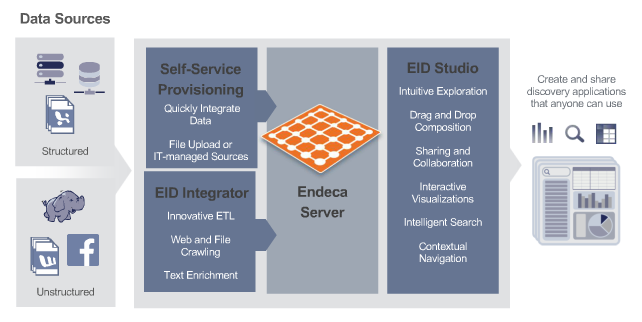This blog is an introduction to Big Data and the analysis of Big Data with Oracle Endeca Information Discovery.
Big Data is a trending topic nowadays. Because of the digitalization, people across the planet are increasingly creating enormous amounts of data. Especially, the rise of social media and mobile devices boosts the numbers. But what is Big Data exactly? Wikipedia is a good start: “Big data is an all-encompassing term for any collection of data sets so large and complex that it becomes difficult to process using on-hand data management tools or traditional data processing applications.” Big Data is mostly linked to the 4 V’s: Volume (large amounts of data), Velocity (Data needs to be analyzed quickly), Variety (Structured and unstructured data) and Value (the big opportunities of Big Data). But there is not a comprehensive definition for Big Data and the way people estimate Big Data differs extremely. However, most people agree on the fact that Big Data will become increasingly important for the survival of businesses. According to Gartner, by 2015, nearly 3 billion people will create large amounts of data, this amount will increase every year. Gartner also assumes that, by 2015, 85% of Fortune 500 organizations are unable to deal with big data in order to accomplish competitive advantage. It is essential for businesses to be able to analyze the large amounts of data in order to survive.
Oracle recognizes the Big Data trend. During a Big Data Event they told us that they treat it as the invention of electricity of this age, based on the estimated impact of Big Data on the world. Oracle Endeca Information Discovery (Endeca), which will be further elaborated in this blog, is the tool of Oracle to analyse Big Data. Endeca is able to analyze structured, semi-structured and unstructured data, which makes it a very powerful and helpful tool in modern business environments, where consumers obtain an increasing voice and businesses need to be able to process large amounts of different data.
Oracle Endeca is a useful tool to explore data and to discover new insight about data. Businesses are able to upload data into Endeca, because of the intuitive (drag & drop) design it is very easy to explore this data.
Oracle Endeca exists out of different components:

The Endeca server stores the data and supports users during analyzing. The Self Service Provisioning is a web application which enables users to load data into the Endeca server. The Endeca Integrator can be used to edit and load large amounts of data into the Endeca server. This tool is useful to load different types of data (structured, semi-structured and unstructured). The Endeca studio is the interactive interface for building the analytics discovery application.
Ebicus is an Oracle Gold partner and Specialized partner for CRM on Demand and Oracle BI Applications. Therefore, Ebicus is very interested in the developments regarding Endeca. Because we are specialized in CRM on Demand and BI, our proposition concerning Endeca is to link CRM with Endeca. On October 7th 2014 Ebicus will organize their yearly Nazomerevent, during this event visitors are able to discover more about Endeca.
Soon, more blogs about Endeca will be available on this site. This blog tried to introduce the comprehensive possibilities of Big Data and the analysis thereof with Endeca, but it is also a wakeup call for businesses. When businesses do not develop themselves and do not have a proactive attitude regarding analysis of data, it might affect their current or future position and they might miss an unique chance. In later blogs, I will explain more about the high added value of the different components of Endeca, such as the Provisioning Service, Integrator and the Endeca Studio.
